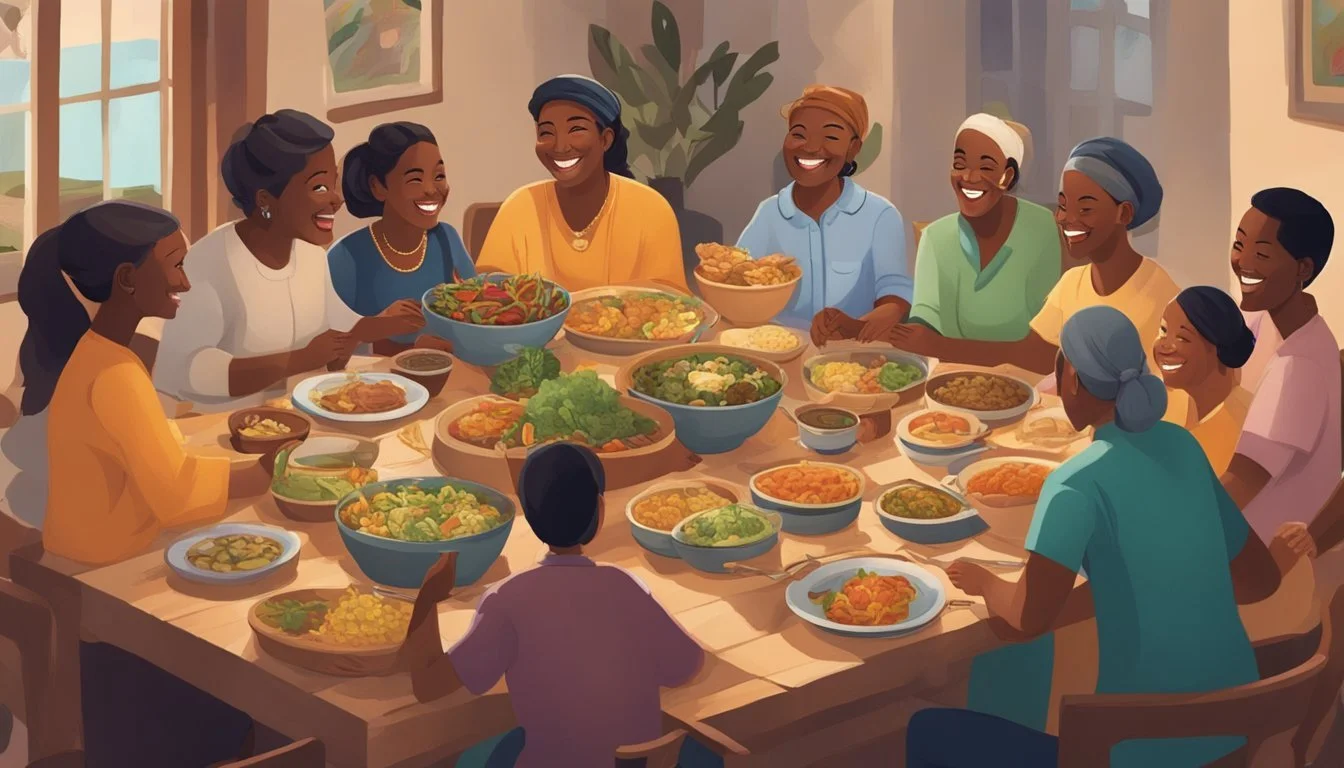11 Tips for Navigating Cultural Differences in a Relationship
Strengthen Your Bond
Navigating cultural differences in relationships can be both challenging and rewarding. Whether it's differences in traditions, customs, or communication styles, understanding and respecting each other's background is key to building a strong connection. By being open-minded and curious about your partner's culture, you lay a solid foundation for mutual respect and appreciation.
How can couples effectively navigate cultural differences and strengthen their bonds? Embracing diversity within a relationship not only enriches the partnership but also provides unique opportunities for growth. Learning how to manage and celebrate these differences can lead to a more harmonious and fulfilling relationship.
1) Learn Their Language Basics
Learning the basics of your partner's language can strengthen your relationship. It shows effort and respect for their cultural background. Simple phrases like "hello," "thank you," and "I love you" can go a long way.
Language learning can be achieved through various methods. Apps, online courses, and language exchange meetups are accessible and effective options. These resources can help you grasp fundamental vocabulary and phrases.
Knowing the basics of their language also facilitates better communication. Misunderstandings are less likely to occur when both parties can express basic needs clearly. Even if fluency isn't achieved, the effort is what counts.
Additionally, learning their language helps you understand cultural nuances. Certain expressions and words may carry cultural significance. Being aware of these can prevent potential offense and deepen your connection.
Practicing regularly is key. Engage in simple conversations with your partner. This not only improves your language skills but also brings you closer together.
2) Celebrate Traditions Together
Celebrating traditions from both cultures can strengthen your relationship. Sharing holidays, festivals, and customs allows you to learn more about each other’s backgrounds. This joint effort creates a deeper connection and mutual respect.
Incorporate elements from each culture into your daily life. For example, you might cook traditional meals together or learn a new language. This practice enriches your relationship and fosters a sense of unity.
Participating in each other’s cultural events shows appreciation and willingness to embrace differences. This step also helps families and friends feel more included and respected.
Adapting and merging traditions can be a meaningful way to honor both heritages. Finding common ground may involve creating new traditions that reflect both cultures. This approach can make celebrations more inclusive and unique.
Learning about and celebrating cultural traditions can reduce misunderstandings and build empathy. It’s not just about the events but the values and stories behind them. This understanding can enhance communication and cooperation.
Establishing new family traditions combines the best of both worlds. This can create a new shared identity and legacy for future generations. Embracing this aspect of your relationship can make it more enriching and fulfilling.
3) Share Your Own Culture
Sharing your culture can bring fresh perspectives and mutual respect into the relationship. By introducing your partner to your traditions, customs, and values, you create opportunities for deep connection and understanding.
Involve your partner in cultural celebrations and rituals. This hands-on experience allows them to appreciate the significance and joy behind your cultural practices. Share the stories and histories that make your culture unique.
Encourage reciprocal sharing by showing genuine interest in your partner’s heritage as well. This mutual exchange fosters empathy and diminishes the likelihood of cultural misunderstandings. It creates a balanced foundation where both cultures are valued equally.
Cook traditional meals together. Food often serves as a gateway to cultural appreciation. Cooking together can be a fun and educational way to explore each other's backgrounds. Describe the ingredients and the history behind the dishes.
Language can also be a beautiful aspect to share. Teach your partner common phrases or expressions in your native language. This can be both enriching and entertaining, adding a layer of intimacy to your relationship.
Sharing your culture requires patience and openness. Encourage questions and be ready to explain the nuances. This dialogue can pave the way for a stronger, more inclusive relationship.
4) Be Open to Different Customs
Being open to different customs is crucial in navigating cultural differences in relationships. Customs may include traditional celebrations, rituals, or ways of interacting with others. Embracing these aspects can strengthen the bond between partners.
A key part of this is observing and participating in your partner’s customs with genuine interest. This shows respect and a willingness to understand their background. It helps bridge cultural gaps and fosters mutual appreciation.
It’s important to ask questions and show curiosity about their customs. Engaging in conversations about traditions allows partners to share and learn from each other. This mutual exchange dispels myths and clarifies any misunderstandings.
Participating in various customs can also lead to new experiences and broaden one's perspective. Whether it’s attending a cultural festival or trying out traditional cuisine, these activities enrich the relationship.
Respect is central to being open to different customs. Avoid making negative judgments or dismissive remarks about practices that are unfamiliar. Maintaining an open mind is key to successfully navigating the complexities of a multicultural relationship.
For example, understanding the role of social norms and behavior in cultural expectations can prevent conflicts. Couples who respect and accommodate each other's customs are more likely to build a harmonious relationship.
5) Plan Cultural Celebrations
Incorporating cultural celebrations into a relationship can build deeper connections. Celebrating each other’s holidays and traditions shows respect and interest.
Mark important dates on your calendar. Participate in cultural festivals, traditional meals, and rituals together. This can enhance mutual understanding and appreciation.
Planning these events together encourages communication. Decide on the activities, menus, and guest lists collaboratively. This ensures both partners feel included and respected.
It’s beneficial to involve family and friends. This can make celebrations more meaningful and introduce your partner to your cultural community.
Even small gestures matter. If major celebrations aren’t possible, consider smaller acts like cooking a traditional meal or watching a cultural movie. This keeps the spirit of the celebration alive and demonstrates thoughtfulness.
6) Travel to Each Other's Hometowns
Experiencing each other's hometowns can provide a deeper connection and understanding of your partner's background. This allows both partners to see where the other grew up, understand their local culture, and meet family and friends who shaped their lives.
Visiting these places helps put shared stories into context. Seeing schools, favorite hangout spots, and significant landmarks can create a stronger bond.
This experience also encourages learning about regional customs, foods, and traditions in a more authentic way. Such firsthand experiences often bring new insights that reading or hearing second-hand might miss.
Engaging with the community where your partner grew up fosters respect and appreciation. Participating in local events and festivities allows both partners to embrace each other's heritage actively.
Traveling together to hometowns also breaks the routine and adds a sense of adventure and discovery to the relationship. It's a unique way to share pieces of personal history and build new memories together.
Through these visits, both partners can grow closer, gaining a more comprehensive perspective on each other's lives.
7) Respect Religious Beliefs
In a relationship, respecting each other's religious beliefs is crucial for harmony. Each partner should acknowledge the faith of the other without imposing their own. This encourages an environment of mutual respect and understanding.
Open communication about religious beliefs helps partners learn more about each other's perspectives. Having these discussions without judgment fosters a deeper connection.
Finding common values between different religions can strengthen the bond. Principles like compassion, love, and forgiveness are often shared across faiths and can be the foundation of the relationship.
Avoiding assumptions about the other's faith is important. Each person’s relationship with their religion is unique, and making assumptions can lead to misunderstandings. Instead, partners should engage in genuine conversations to explore these aspects.
Partners should remain open to learning about each other's beliefs. Respecting religious differences includes exploring and acknowledging the significance of various rituals and traditions in each other's lives.
It’s essential to manage emotions during religious discussions. Staying calm and resisting the urge to argue ensures that conversations remain respectful and constructive. Recognizing everyone's right to personal beliefs prevents conflicts.
Supporting each other in religious practices shows respect and strengthens the relationship. Whether attending services together or showing interest in religious holidays, these acts of support reinforce commitment and respect in the relationship.
8) Cook Traditional Foods
Cooking traditional foods together can be a delightful way to embrace cultural diversity in a relationship. It provides an opportunity to learn about each other's heritage through the lens of culinary practices.
Sharing and preparing traditional dishes can strengthen the bond between partners. They can explore recipes, shop for ingredients, and cook together, enhancing mutual understanding and appreciation of their backgrounds.
Food can be an expressive and enjoyable aspect of culture. By cooking each other's traditional meals, partners show respect for and interest in their differing customs. This practice can help bridge cultural gaps and foster a sense of unity.
Trying out and enjoying each other's cuisines can be a fun and educational experience. This engagement invites conversations about the origins, significance, and techniques of various dishes.
Respecting dietary restrictions and food taboos in different cultures is also important. Some cultures have specific dietary laws that must be followed. Acknowledging and respecting these can reflect deep consideration for the partner's cultural values.
Integrating both cultures into everyday life through food can create new traditions. For example, they could celebrate holidays with a blend of culinary practices, making the occasion special and inclusive.
9) Understand Family Dynamics
Understanding family dynamics is crucial in navigating cultural differences in a relationship. Different cultures have unique ways of viewing family roles and responsibilities. Awareness of these differences can help in managing expectations and reducing conflicts.
Extended families often play a significant role in many cultures. Engaging with and respecting the partner's family can strengthen the relationship. Regular interaction with family members can provide insights into their values and traditions.
Gender roles within families can vary widely between cultures. Discussing these roles openly can help align expectations and responsibilities in the relationship. This ensures both partners feel respected and understood.
Navigating family dynamics also involves adapting to differing parenting styles if children are involved. Understanding and respecting each other's approaches to parenting can create a harmonious family environment. Working together to blend traditions can benefit everyone involved.
Communication is key when dealing with family dynamics. Encouraging open dialogue about family expectations and traditions can foster mutual respect and understanding. This helps in creating a balanced relationship that honors both cultures.
For further guidance, reading articles like Navigating Cultural Differences in Relationships can offer practical tips. Engaging in such resources can enhance cultural awareness and improve relationship dynamics.
10) Discuss Cultural Expectations
Discussing cultural expectations is essential in any cross-cultural relationship. Each person brings their own cultural norms and values, which can influence the relationship dynamics. Open conversations about these expectations can prevent misunderstandings and build a stronger foundation.
Partners should take the time to share specific cultural practices that are important to them. This could include holiday traditions, family roles, or dietary preferences. Knowing these details helps each person feel respected and valued.
Explore differences with an open mind. Avoid assumptions about what is considered normal or acceptable. Asking questions and being genuinely interested in the answers fosters mutual respect and appreciation for each other's backgrounds.
It's beneficial to address any potential conflicts arising from differing cultural expectations early on. This proactive approach can prevent small issues from escalating into bigger problems. Discussing how to navigate these differences together can lead to more effective solutions.
Adjustments may be necessary as the relationship progresses. Both partners should remain flexible and willing to adapt. This adaptability shows a commitment to making the relationship work despite cultural variances.
Maintaining ongoing communication about cultural expectations is crucial. Cultures evolve, and people's adherence to cultural norms can change over time. Regular check-ins help ensure both partners remain aligned and understanding of each other's cultural influences.
For more insights on managing these discussions, consider exploring additional resources like this article.
11) Learn About Cultural Norms
Understanding your partner's cultural norms is essential in navigating cross-cultural relationships. Cultural norms include the behaviors, attitudes, and traditions that shape how people interact in various situations. These norms vary widely from one culture to another.
One effective way to learn about cultural norms is to engage in open conversations with your partner about their background. These discussions can provide valuable insights into their experiences and expectations.
Reading books, articles, and reputable websites on the topic can also be helpful. For instance, you can visit sites like Love Across Cultures for information. Such resources offer a comprehensive understanding of different cultural practices and etiquette.
Spending time with your partner's family and friends can also help. This social interaction offers firsthand experience of their culture's social norms. It provides a deeper appreciation of your partner's customs and traditions.
Attending cultural events and festivals is another excellent method. These events showcase the richness of a culture and offer a fun way to learn about different traditions and practices.
Asking questions when you're unsure is crucial. It shows respect and a willingness to understand and embrace your partner's culture.
Respect for cultural norms fosters mutual respect and helps build a solid foundation for your relationship. It bridges gaps and minimizes misunderstandings, allowing both partners to feel valued and appreciated.
Understanding Cultural Backgrounds
Recognizing and appreciating cultural backgrounds can enhance mutual respect and communication in relationships. Key areas to focus on include cultural norms, historical influences, and religious practices.
Cultural Norms and Values
Cultural norms and values form the bedrock of any society. They guide behaviors, traditions, and social interactions. For instance, some cultures prioritize individualism, focusing on personal goals and achievements. Others emphasize collectivism, valuing group harmony and familial bonds.
Understanding these differences can prevent misunderstandings. For example, in individualistic cultures, direct communication and assertiveness may be seen as positive traits. In contrast, indirect communication and humility might be more valued in collectivist cultures. Recognizing these diverse communication styles can foster better interactions.
Respecting each other’s cultural norms involves being open to various viewpoints and practices. It’s crucial to ask questions with genuine curiosity and without judgment.
Historical Context
The historical experiences of a culture deeply influence its current values and behaviors. Historical events such as colonization, migration, or major conflicts can shape collective memories and identities. Understanding these historical contexts provides insight into why certain customs or attitudes prevail.
For example, countries with histories of colonization may have complex attitudes towards foreign influences and languages. In relationships, acknowledging and respecting these historical nuances can build a deeper connection and avoid potential pitfalls.
Discussing family histories and ancestral narratives can also be enlightening. It enriches the relationship with stories that offer a deeper comprehension of each other’s backgrounds.
Religious Beliefs and Practices
Religious beliefs and practices are integral to many cultures. They often dictate daily routines, dietary restrictions, festivals, and life milestones. Understanding a partner’s religious context can foster respect and adaptability.
Different religions have various expectations regarding behavior, dress, and even financial management. For instance, some religions have specific dietary laws such as halal or kosher. Recognizing and accommodating these practices in a relationship shows respect and commitment.
It’s beneficial to learn about significant religious holidays and rituals. Participating in or at least acknowledging these customs can strengthen the bond between partners. Open discussions about religious beliefs can also clarify potential areas of conflict and finding mutually respectful solutions.
Effective Communication Strategies
Effective communication is essential in navigating cultural differences in a relationship. Key strategies include active listening, understanding non-verbal cues, and addressing language barriers.
Active Listening
Active listening involves fully concentrating on what the other person is saying rather than just passively hearing the message. It requires attention to both verbal and non-verbal messages, such as tone of voice and body language.
Asking clarifying questions shows genuine interest and ensures understanding.
Paraphrasing what was said can confirm that the message was understood correctly.
Avoiding interruptions allows the speaker to express themselves without feeling rushed.
These practices help in fostering a deeper connection and reducing misunderstandings in intercultural relationships.
Non-Verbal Cues
Non-verbal communication can vary greatly between cultures and includes gestures, body language, facial expressions, and eye contact. Understanding these differences is crucial:
In some cultures, direct eye contact is seen as a sign of confidence, while in others, it can be perceived as aggressive.
Hand gestures may have different meanings; for example, a thumbs-up is positive in some countries but offensive in others.
Personal space preferences can differ significantly, with some cultures appreciating close proximity and others valuing distance.
Being aware of these variations can help in interpreting non-verbal signals accurately and avoiding miscommunications.
Language Barriers
Language barriers can be a significant challenge in intercultural relationships, but several strategies can help overcome this obstacle:
Learning basic phrases in the partner's language shows effort and respect.
Using simple and clear language reduces the chances of misunderstandings.
Technology such as translation apps can be useful for immediate communication needs.
Patience and willingness to adapt play a crucial role in overcoming language barriers. Additionally, non-verbal cues and active listening can support clearer communication even when words fail.







